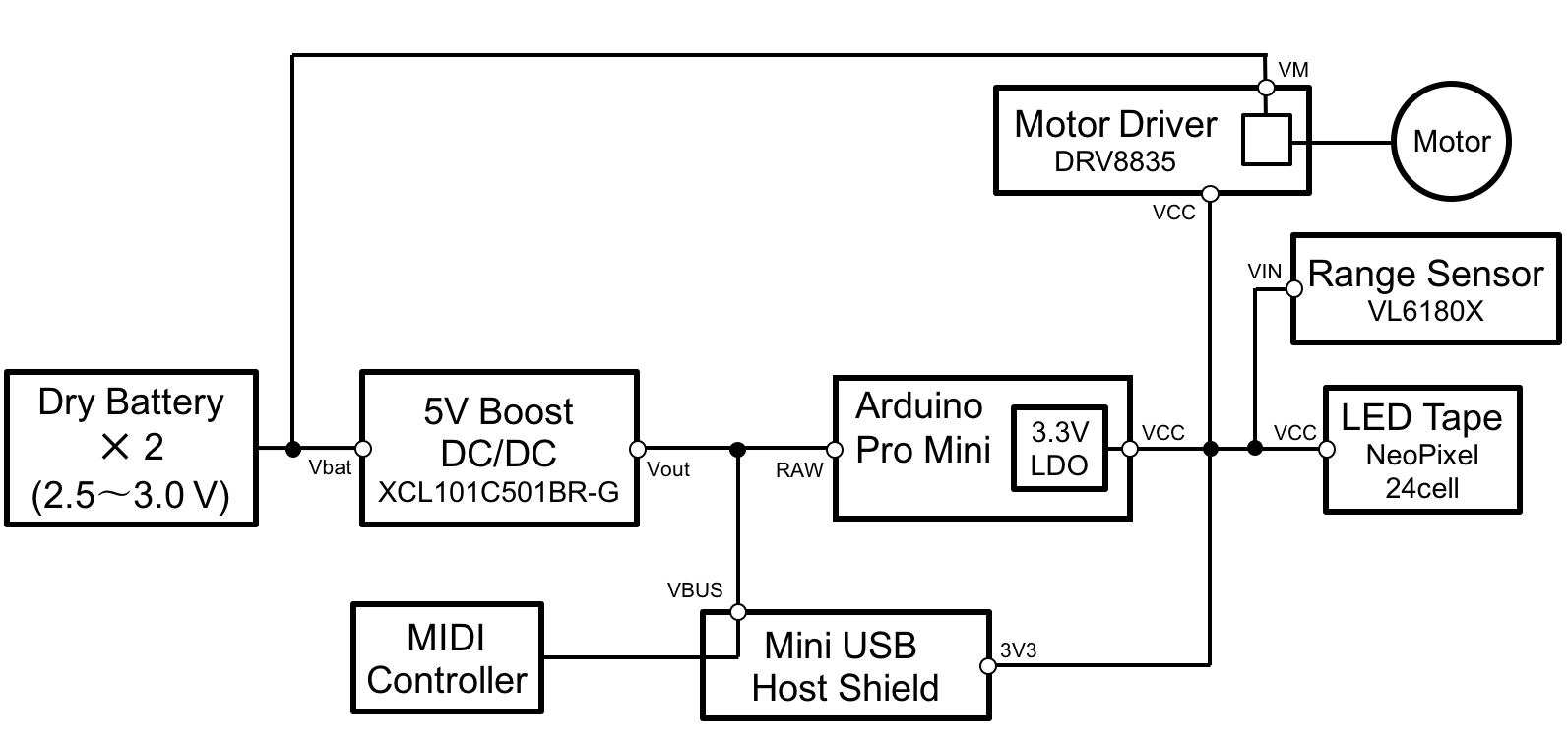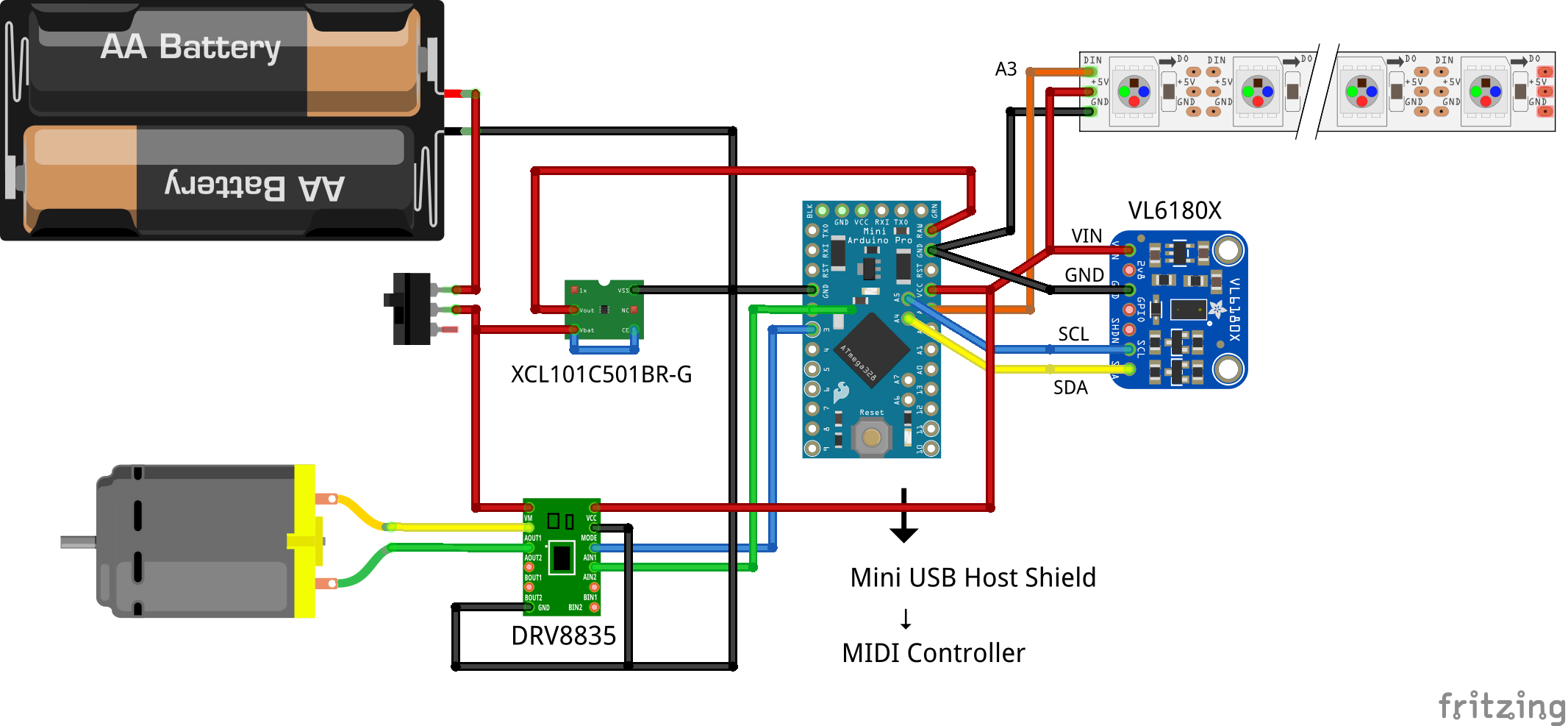I simplified the power supply to handle portable. I adopted dry batteries.
Power supply schematic

It was difficult to completely eliminate the motor drive noise, so 5V DC / DC boost convertor and 3.3V LDO in the microcomputer were used for the control system power supply.
Structure
Using two dry batteries

Arduino IDE Code
I used the following as a USB MIDI library
https://github.com/felis/USB_Host_Shield_2.0
I programmed with reference to the following
https://github.com/felis/USB_Host_Shield_2.0/tree/master/examples/USBH_MIDI/USBH_MIDI_dump
The library for distance sensor VL6180X is below.
https://github.com/pololu/vl6180x-arduino
The library for NeoPixel is below.
https://github.com/adafruit/Adafruit_NeoPixel
#include <usbh_midi.h>
#include <usbhub.h>
#include <SPI.h>
#include <Wire.h>
#include <VL6180X.h>
#include <Adafruit_NeoPixel.h>
USB Usb;
USBH_MIDI Midi(&Usb);
uint8_t Note, oldNote;
VL6180X sensor;
int meas;
int aim = 50;
int diff = 5;
#define PIN A3
#define NUM_LEDS 24
#define BRIGHTNESS 30
int num;
Adafruit_NeoPixel strip = Adafruit_NeoPixel(NUM_LEDS, PIN, NEO_GRBW + NEO_KHZ800);
void MIDI_poll();
void setup() {
Serial.begin(115200);
Wire.begin();
pinMode(2, OUTPUT);
pinMode(3, OUTPUT);
digitalWrite(2, LOW);
digitalWrite(3, LOW);
sensor.init();
sensor.configureDefault();
sensor.setTimeout(500);
strip.setBrightness(BRIGHTNESS);
strip.begin();
strip.show();
if (Usb.Init() == -1) {
while (1); //halt
}
delay( 200 );
}
void loop() {
Usb.Task();
if ( Usb.getUsbTaskState() == USB_STATE_RUNNING ) {
MIDI_poll();
}
}
// Poll USB MIDI Controler and drive motor
void MIDI_poll() {
char buf[20];
uint8_t bufMidi[64];
uint16_t rcvd;
if (Midi.RecvData( &rcvd, bufMidi) == 0 ) {
if(bufMidi[0] == 9){
Note = bufMidi[2];
Serial.println(Note);
//Initial operation of the motor
if(Note > oldNote){
digitalWrite(2, HIGH);
digitalWrite(3, LOW);
}else{
digitalWrite(2, LOW);
digitalWrite(3, HIGH);
}
delay(50);
digitalWrite(2, LOW);
digitalWrite(3, LOW);
}
}
//Slide distance setting
if(Note == 57) aim = 19; //A
if(Note == 58) aim = 29; //A#
if(Note == 59) aim = 39; //B
if(Note == 60) aim = 49; //C
if(Note == 61) aim = 59; //C#
if(Note == 62) aim = 67; //D
if(Note == 63) aim = 78; //D#
if(Note == 64) aim = 85; //E
if(Note == 65) aim = 93; //F
if(Note == 66) aim = 102; //F#
if(Note == 67) aim = 109; //G
if(Note == 68) aim = 112; //G#
if(Note == 69) aim = 120; //A
if(Note == 70) aim = 124; //A#
if(Note == 71) aim = 129; //B
if(Note == 72) aim = 131; //C
//Distance sensor measurement
meas = sensor.readRangeSingleMillimeters();
//Serial.println(meas);
//LED On
num = map(meas, 22, 133, 4, 23);
for(int i=num; i<strip.numPixels(); i++) {
strip.setPixelColor(i, Wheel(255/strip.numPixels() * i));
//delay(100);
}
strip.show();
//Motor operation
if(meas > (aim - diff) && meas < (aim + diff)){
digitalWrite(2, LOW);
digitalWrite(3, LOW);
}else if(meas > aim){
digitalWrite(2, LOW);
digitalWrite(3, HIGH);
}else if(meas < aim){
digitalWrite(2, HIGH);
digitalWrite(3, LOW);
}
//LED Off
strip.clear();
oldNote = Note;
}
// Input a value 0 to 255 to get a color value.
// The colours are a transition r - g - b - back to r.
uint32_t Wheel(byte WheelPos) {
WheelPos = 255 - WheelPos;
if(WheelPos < 85) {
return strip.Color(255 - WheelPos * 3, 0, WheelPos * 3,0);
}
if(WheelPos < 170) {
WheelPos -= 85;
return strip.Color(0, WheelPos * 3, 255 - WheelPos * 3,0);
}
WheelPos -= 170;
return strip.Color(WheelPos * 3, 255 - WheelPos * 3, 0,0);
}
 HomeMadeGarbage
HomeMadeGarbage
Discussions
Become a Hackaday.io Member
Create an account to leave a comment. Already have an account? Log In.